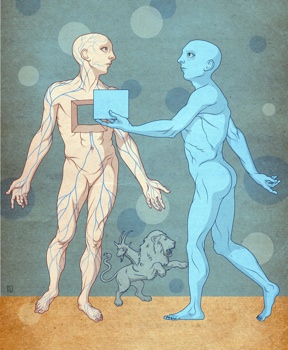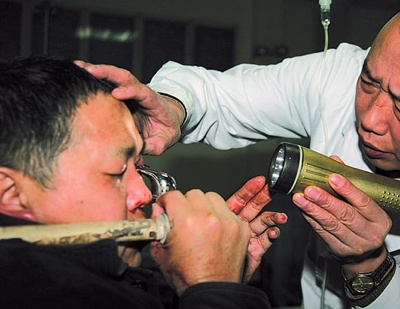 Animals
Animals  Animals
Animals  History
History 10 Most Influential Protests in Modern History
 Creepy
Creepy 10 More Representations of Death from Myth, Legend, and Folktale
 Technology
Technology 10 Scientific Breakthroughs of 2025 That’ll Change Everything
 Our World
Our World 10 Ways Icelandic Culture Makes Other Countries Look Boring
 Misconceptions
Misconceptions 10 Common Misconceptions About the Victorian Era
 Mysteries
Mysteries 10 Strange Unexplained Mysteries of 2025
 Miscellaneous
Miscellaneous 10 of History’s Most Bell-Ringing Finishing Moves
 History
History 10 Great Escapes That Ended Right Back in Captivity
 Weird Stuff
Weird Stuff 10 Fascinating Things You Might Not Know About Spiders
 Animals
Animals 10 Animals That Humiliated and Harmed Historical Leaders
 History
History 10 Most Influential Protests in Modern History
 Creepy
Creepy 10 More Representations of Death from Myth, Legend, and Folktale
Who's Behind Listverse?

Jamie Frater
Head Editor
Jamie founded Listverse due to an insatiable desire to share fascinating, obscure, and bizarre facts. He has been a guest speaker on numerous national radio and television stations and is a five time published author.
More About Us Technology
Technology 10 Scientific Breakthroughs of 2025 That’ll Change Everything
 Our World
Our World 10 Ways Icelandic Culture Makes Other Countries Look Boring
 Misconceptions
Misconceptions 10 Common Misconceptions About the Victorian Era
 Mysteries
Mysteries 10 Strange Unexplained Mysteries of 2025
 Miscellaneous
Miscellaneous 10 of History’s Most Bell-Ringing Finishing Moves
 History
History 10 Great Escapes That Ended Right Back in Captivity
 Weird Stuff
Weird Stuff 10 Fascinating Things You Might Not Know About Spiders
10 Bizarre and Fascinating Medical Tales
The medical world is full of tales of the bizarre, ranging from rare, mysterious diseases to odd medical anomalies. Today’s list will focus on ten of these fascinating stories. Add your own favorites to the comments.
Remember Mr. Spock and his green Vulcan blood in Star Trek? Apparently, it can happen. In October 2005, at St Paul’s Hospital in Vancouver, doctors were inserting an arterial line into a 42-year old patient to relieve pressure in his legs after falling asleep in a kneeling position when they were startled to see dark green blood trickle out of the patient instead of the usual bright red. The initial diagnosis of the doctors is methemoglobin, a dangerous condition in which the hemoglobin in blood can’t bind to oxygen. Analysis of the samples taken from the patient revealed another condition called sulfhemoglobinemia, a rare condition where hydrogen sulfide combines with ferric ions in blood to form sulfhemoglobin, which causes the blood to turn dark green. According to the doctors, the disorder can be triggered by excessive doses of medications containing sulfonamides (sumatriptan, a migraine medication, in the case of the patient, although it’s still unclear). The disorder usually goes away with red blood cell turnover, although blood transfusions may be needed in extreme cases.
When Karen Keegan, a 52-year old Boston teacher, needed a kidney transplant, her three sons were tested if they are acceptable donors. Soon the tests revealed that two of Keegan’s sons did not match Keegan genetic profile. Further tests showed that Keegan has chimerism, a condition where two fraternal twins grow in the womb, but the first twin ‘absorbs’ the other twin, making the resulting embryo contain two different sets of DNA, oftentimes in different parts of the body. To prove that Keegan is indeed the boys’ mother, doctors began tracking the second DNA set in her body, and found it in her thyroid gland.
To learn more about chimerism, check out the highly publicized case of Lydia Fairchild here.
Natalie Adler, a young woman from Melbourne, Australia, is the victim of an extremely rare disorder that left her practically blind three days out of every six. Her eyes will suddenly close involuntarily and she cannot open them until three days later, when it will close again. It first started one Sunday morning when she was Year 11. She had just contracted a sinus and staph infection and woke up with swollen eyes. After that, the condition started. At first the clamping of the eyes occurred randomly, but after a while, it began following a cycle. Hundreds of eye specialists run tests on Adler, but couldn’t find a direct cause, or a cure for the disorder. For two years however, doctors treated Adler using Botox injections on her face, making her see five days out of six, but the treatment no longer works.
Margaret Wegner, after suffering numerous headaches and nosebleeds for 55 years, finally underwent surgery on August 2007. What was the surgery for? To remove a three-inch pencil that was lodged in Wegner’s head after a childhood accident when she was four. Due to lack of technology and fear of irreversibly damaging Wegner’s head, doctors delayed the removal of the pencil for more than five decades until the doctors found the exact location of the pencil in her head and safely took most of it out. “This was something unique because the trauma was so old,” said Dr. Hans Behrbohm, an ear, nose and throat specialist at Berlin’s Park-Klinik Weissensee, who pinpointed the location of the pencil. “She shouldn’t suffer any longer,” he said.
Xu Pinghui, a 12-year old girl from Chongqing started laughing non-stop after developing fever when she was just eight months old. Because of the mysterious condition, the girl has lost the ability to speak at two years old, and can only communicate through giggling. The cause of the disease is still a mystery, although doctors said that it might have been caused by damage to the frontal lobe due to the fever, and specialists are currently testing the theory.
Yi Zhao, a 57-year old from Chongqing, China, was rushed into the emergency room after accidentally impaling his eye socket with a bathroom faucet after firefighters cut off the pipes. At the hospital, the faucet made it impossible to perform a CT scan, so a plumber was called to remove a foot of pipe jutting out of his eye, but when it didn’t work, an impatient Zhao decided to remove the faucet himself, with the doctor’s guidance. Miraculously, there was little damage to the eye, and no damage to the brain, only fractures to the facial bones.
54-year old Jim McClatchey of Atlanta, Georgia, was rushed to the hospital by his wife after she found him on the floor of their house unconscious. Doctors who were trying to revive him ended up shocking his heart 100 times as the patient kept having repeated cardiac arrests due to an unknown virus. In the first hour alone, McClatchey’s heart stopped an incredible 50 times! He had to be defibrillated so frequently that he suffered second-degree burns to his chest. Shockingly (bad pun alert), he survived the ordeal and he was back at work in no time flat.
63-year old William Sheridan of New York was just recovering from a heart transplant when he inexplicably developed a passion for art, and started making beautiful sketches. He found out later that his organ donor was an artist. This odd phenomenon, called cellular memory, is the theory that the brain is not the only part of the body that contains memory and human traits, and that other organs such as the heart and hands, can contain them too. Several studies have focused on this phenomenon, a notable one being Dr. Paul Peasall’s study entitled ‘Changes in Heart Transplant Recipients That Parallel the Personalities of Their Donor,’ which was published in Near-Death Studies Magazine in 2002. To learn more about cellular memory, go here.
Lakshmi Tatma, a girl born in 2005 in Bihar, India, was born a conjoined twin, with her parasitic twin’s headless body joined to her at her pelvis, giving her the appearance of having 4 arms and 4 legs. Lakshmi (named after the many-armed Hindu goddess of wealth) has a rare condition called isciopagus, where her twin has stopped developing in the womb and the remaining fetus absorbed the underdeveloped twin’s body. Aside from 8 limbs, Lakshmi has two spines, four kidneys and two stomach and chest cavities. That is, until the toddler underwent a successful 27-hour surgery at a hospital in Bangalore to remove the extra parts.
Mark Chenoweth gets the top spot of this list for his amazing story. Chenoweth, who has spent the past ten years in a wheelchair, was born with spina bifida, a crippling disease that left him unable to walk. In 1998, he consulted his doctor about taking scuba diving lessons, which the doctor immediately forbade. Against his doctor’s orders, he took a holiday to Minorca and managed to persuade a diving center to give him scuba lessons. Diving to a depth of 55 ft, after he surfaced, he found out that he can walk again. Three days later, his legs lost sensation once more, so he immediately went back to scuba diving. After a while, he noticed that the deeper he gets, the longer the time he can walk after. Due to this, Chenoweth now uses his wheelchair only twice a year. It is not exactly known why this happened, but one theory suggests that the rich mix of oxygen in the aqualungs divers used affected the nerve cells afflicted by the spina bifida, making them temporarily work.


















